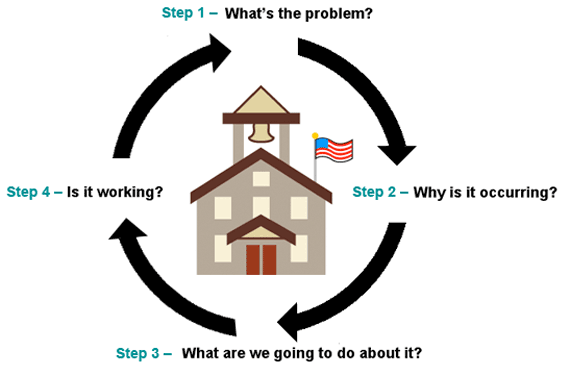Step 1 - What's the problem?
Step 2 - Why is it occurring?
Step 3 - What are we going to do about it?
Step 4 - Is it working?

Step 1
Define the problem or goal by determining the difference between what is expected and what is occurring. Ask, “What specifically do we want students to know and be able to do when compared to what they do know and are able to do?” When engaged in problem solving at the individual student level, the team should strive for accuracy by asking, “What exactly is the problem?”
Step 2
Analyze the problem using data to determine why the issue is occurring. Generate hypotheses (reasons why students are not meeting performance goals) founded in evidence-based content area knowledge, alterable variables, and instructionally relevant domains. Gather assessment data to determine valid/non-valid hypotheses. Link validated hypotheses to instruction/intervention so that hypotheses will lead to evidence-based instructional decisions. Ask, “Why is/are the desired goal(s) not occurring? What are the barriers to the student(s) doing and knowing what is expected?” Design or select instruction to directly address those barriers.
Step 3
Develop and implement a plan driven by the results of the team’s problem analysis by establishing a performance goal for the group of students or the individual student and developing an intervention plan to achieve the goal. Then delineate how the student’s or group of students’ progress will be monitored and implementation integrity will be supported. Ask, “What are we going to do?”
Step 4
Measure response to instruction/interventions by using data gathered from progress monitoring at agreed upon intervals to evaluate the effectiveness of the intervention plan based on the student’s or group of students’ response to the intervention. Progress-monitoring data should directly reflect the targeted skill(s). Ask, “Is it working? If not, how will the instruction/intervention plan be adjusted to better support the student’s or group of students’ progress?” Team discussion centers on how to maintain or better enable learning for the student(s).

